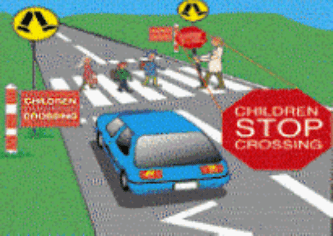DKT Test (Pedestrians) #2
When you encounter children on or near the road, you should?
Explanation:
Children are unpredictable, and they may attempt to cross the road when it is not safe. Prepare to come to a stop.
If there is no crosswalk and you notice a pedestrian crossing your lane, you should do the following:
Explanation:
Even if there isn't a clearly marked crosswalk, drivers must always give way to pedestrians in the road.
Which of the following should you prioritize when driving past parked cars:
Explanation:
Animals and pedestrians may be hidden by other vehicles. They might try to cross in front of your car since they don't notice you. Additionally, avoid driving too closely to parked automobiles because you run the danger of being hit by someone opening one. However, unless turning right or passing another vehicle, you should continue to drive in the left-hand lane.
You must hold off crossing the street if you see a school crossing supervisor carrying a sign like this until the children have:

Explanation:
Only after the sign is taken down are you able to proceed. You must remain stopped until that time.
A vehicle in front of you has stopped at a crosswalk for pedestrians. You:
Explanation:
The car may block the view of pedestrians. You must not overtake it.
At a pedestrian crosswalk:
Explanation:
At street crossings, pedestrians have the right-of-way but are still required to abide by traffic signals. Vehicles must stop for pedestrians in a crosswalk, whether it is marked or not, when there isn't a traffic signal present.
If a car is coming from behind and you want to pass a pedestrian who is crossing the street, you should:
Explanation:
If at all possible, deal with only one traffic hazard at a time. If a vehicle is coming from behind and you wish to pass the pedestrian, slow down and let the car pass. The pedestrian may then be passed if it is safe to do so.
When passing a car in front of you on a road without lane markings:
Explanation:
Before overtaking, you should always indicate your intention.
On a marked pedestrian crossing, you must give way to pedestrians:
Explanation:
If a pedestrian is crossing the street, you must give way if you are in danger of colliding with them.
If you come across an elderly person on or near the road, you should:
Explanation:
Older people's vision and hearing may be reduced, making it more difficult for them to see your car.
When driving in an area with a lot of pedestrians (like a bus stop), remember to:
Explanation:
Pedestrians who attempt to cross in front of your car may be obscured by a bus. Be ready to come to a halt if required.
Are you permitted to stop in this loading zone to pick up passengers?

Explanation:
If you are not driving a car that is primarily built for carrying goods, you cannot park in a loading zone. Driving any other kind of vehicle only allows you to pull over to pick up or drop off people at the curb.
Which of the following statements is correct?
Explanation:
Avoid colliding with a pedestrian at all costs.
If there are elderly or children on a pedestrian crossing, you will almost certainly need to:
Explanation:
It may take a little longer for elderly persons and children to securely cross the crossing. Patience is required.
If you notice a pedestrian walking with a cane or guide dog:
Explanation:
Blind or partially sighted pedestrians are permitted to use a white cane or a guide dog. A pedestrian with a white cane or a guiding dog requires you to give way.
What should a motorist do if they notice pedestrians in an oncoming crosswalk?
Explanation:
Drivers are required to give pedestrians in a crosswalk the right of way. When the intersection is clear, the motorist should proceed.
You approach a Light Rail car that has just come to a complete halt at a tram stop. What is the most critical action you should take?
Explanation:
Pedestrians disembarking from the tram may attempt to cross in front of your vehicle.
Which of the statements below is correct?
Explanation:
If there's a danger you'll collide with a pedestrian, you must yield.
How close may the vehicle park to the crossing for pedestrians?
Explanation:
Parking is prohibited within 10 or 20 meters of pedestrian crossings. The vehicle must be parked at least 10 meters ahead of the crossing.
The road in front of you has these zigzag markings. What exactly do they imply?
Explanation:
A zigzag line indicates that you are approaching a pedestrian crossing, even if you don't see it right away.